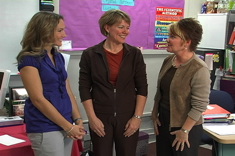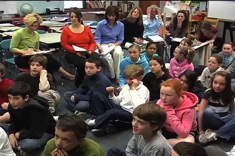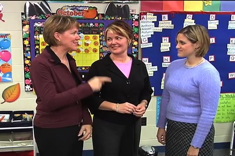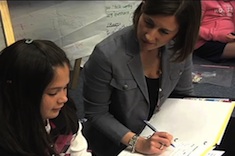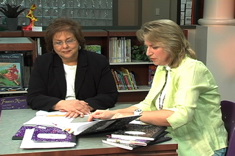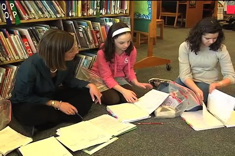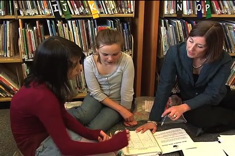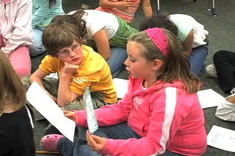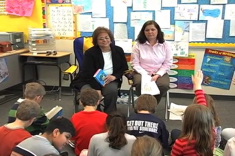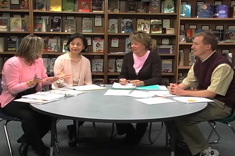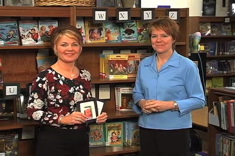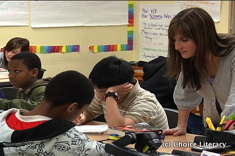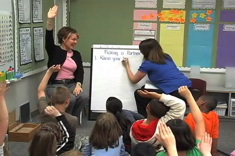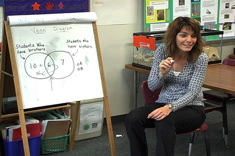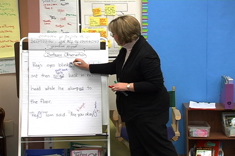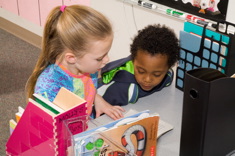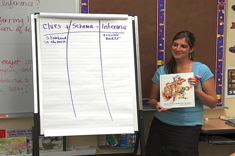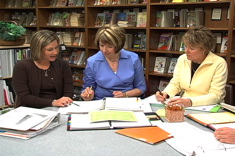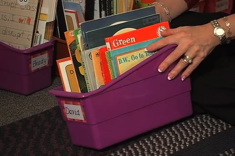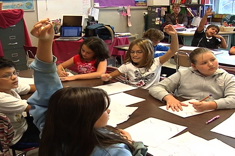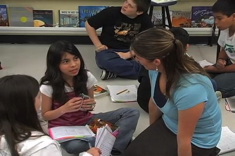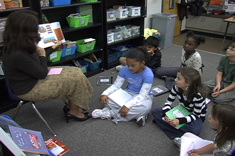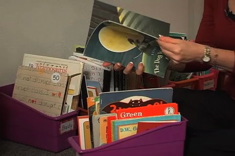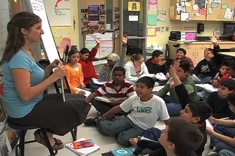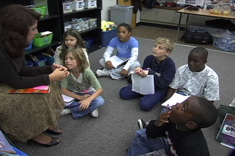Videos
Here is where you’ll find all the latest videos from our contributors. These videos are all captured in classrooms with crews using multiple cameras during regularly scheduled reading and writing workshops.
Latest Content
Makeover for the Teacher Desk Area
"The Sisters" (Gail Boushey and Joan Moser) work with Sarah Thibault and friends in Maine to makeover the teacher desk area in her 4th grade classroom.
Demonstration Lesson: Inferring Character Traits
In this demonstration lesson from a 5th grade classroom, Clare Landrigan leads students through a reading and discussion of inference and character development.
3rd Grade Meeting Area Makeover
Are your meeting area wall displays too cluttered? "The Sisters" (Gail Boushey and Joan Moser) help a 3rd grade teacher rethink her wall displays and meeting area in this ten-minute video.
Conferring About Character Traits
In this conference from a fifth-grade classroom, Clare Landrigan meets with a student to reinforce learning from a whole-class lesson on inferring and character traits.
Teacher/Principal Conferring: Reflecting on Readers’ Notebooks
In this conference, Principal Karen Szymusiak and 5th grade teacher Liz Cramer discuss the ways Liz uses readers’ notebooks in her classroom.
Running and Reading Logs
In this first video in a two-part series, Clare Landrigan meets with a group of fourth graders to talk about reading logs and goals. In this excerpt, Clare uses the analogy of how runners use logs to chart progress and set goals.
Small Group After Demonstration Lesson
In this small group after a demonstration lesson in a 5th grade classroom, Clare Landrigan talks through strategies for inferring the meaning of new words while reading.
Running and Reading Logs Part II
In this second video in a two-part series, Clare Landrigan meets with a group of 4th graders to talk about reading logs and goals. In this excerpt, Clare confers with students over their logs and debriefs with their teacher.
Linking Math and Writing Through Word Problems
In this six-minute video, Franki Sibberson demonstrates how she helps her 3rd and 4th grade students make connections between writing workshop and math problem solving.
Finding Words: Linking Community and Classrooms
Principal Karen Szymusiak and 3rd Grade Teacher/Literacy Coach Pam Hahlen do a quick word search activity using dictionaries donated to the classroom by a local service club.
Grade Level Team Meeting: Test Preparation
In this video of a 3rd grade team meeting, literacy coaches Janet Scott and Gail Boushey help third-grade teachers think through what is going well with test preparation, and what might be adapted before the tests begin in a few weeks.
Bookroom Tours Part III
In this six-minute video, The Sisters (Gail Boushey and Joan Moser) give a tour of a “choice” bookroom. Unlike many bookrooms organized by level and maintained by teachers, this room of chapter books is organized by author.
Weekend Headlines: Introduction
In this first of a three-part video series, Katie Doherty and her sixth grade students begin the Weekend Headlines activity. Each Monday, students listen to Katie share some of the headlines from the local newspaper and then share their "headlines" from the weekend.
Picking a Partner: Demonstration Lesson and Debrief
In this demonstration lesson from a K-2 classroom, Joan Moser leads students through guided practice in picking a partner.
4th Grade Room Tour
In this video tour of her 4th grade classroom, Aimee Buckner highlights how she arranges books, charts, and other resources to support the reading and writing of her students.
Writing Comics: Introducing the Activity
In this lesson from a fourth-grade classroom, Sarah Thibault introduces students to a writing activity. Students will be creating their own comic books, after extensive preparation and experience with mentor texts.
Test-Taking Strategies Part III: Whole Class Debrief
Andrea Smith’s 4th graders debrief together after a test preparation workshop.
5th Grade Sentence Observation
Karen Terlecky explains the sentence observation routine in her 5th grade classroom, and provides a video example of students in action analyzing sentences.
Managing Book Boxes
In this first video in our “Organizing Book Boxes” series, Joan Moser (of “The Sisters”) explains three strategies she uses to help students pick books for their book boxes.
Learning from Graphica: Conferring with Students
In this lesson series from a 4th grade classroom, Sarah Thibault introduces students to a writing activity. Students will be creating their own comic books, after extensive preparation and experience with graphica. In this installment, Sarah confers with students during writer's workshop as they brainstorm character traits. Students will be creating their own comic books, after extensive preparation and multiple reading and writing activities.
Inferring Read Aloud Part I
Katie Doherty demonstrates how she uses picture books to teach inferring strategies to her sixth graders in this video series. Part I is a presentation of the book to students.
Chatting About Coaching Collaboration
Gail Boushey and Janet Scott discuss how they collaborate as coaches, sharing strategies and common goals across the classrooms they work in.
Differentiating Book Boxes
In this second video in our "Organizing Book Boxes" series, Joan Moser (of "The Sisters") explains how she differentiates the content of book boxes for students with different skills and needs.
Learning from Graphica: Class Discussion
This is the third installment of a video series on using graphica in a 4th grade classroom. In this episode, Sarah Thibault debriefs with her class after writing workshop. Students are creating their own comic books, after extensive preparation and multiple reading and writing activities.
Teaching Inferring with Picture Books Part II: Partner Shares
Katie Doherty’s 6th grade students discuss the read-aloud through partner shares.
4th Grade Small Group: Writing Paragraphs
In this video, Aimee Buckner uses a mentor text to demonstrate how writers construct lively nonfiction paragraphs.
Book Boxes Nuts and Bolts
In this third video in our "Organizing Book Boxes" series, Joan Moser (of "The Sisters") tackles the issue of what types of books and what levels are appropriate for student book boxes.
1st Grade Room Tour with Kelly Yahr
In this four-minute video, Kelly Yahr introduces viewers to her 1st grade classroom. Kelly emphasizes how much ownership students have of wall displays and the library, especially through their writing and lettering of materials.
Teaching Inferring with Picture Books Part III: Whole-Class Debrief
Katie Doherty's 6th grade students debrief after a read-aloud and partner share focused on inferring.
4th Grade Small-Group Lesson: Dialogue
One of the challenges of working with intermediate writers is helping them understand how and when to use dialogue in their writing. In this video of a small-group lesson, Aimee Buckner uses a mentor text and a metaphor to help her 4th grade students understand the value of using dialogue sparingly in their writing.
Browse Content By
Type
Category
- Assessment Tools
- Big Fresh Archives
- Booklists
- Choice Numeracy
- Classroom Design
- Common Core
- Community Building
- Conferring
- Content Literacy
- Digital Literacy
- English Language Learners
- Equity
- Family Relations
- Free Samples
- Guiding Groups
- Leadership
- Literacy Coaches
- Mentor Texts
- Minilessons
- New Teacher Mentors
- Podcasts
- Poetry
- Quote Collections
- Reading Strategies
- Self Care
- Struggling and Striving Learners
- Talking and Listening
- Teacher Study Groups
- Teaching Reading
- Teaching Writing
- Word Study and Vocabulary
Author
- Melissa Quimby
- Nawal Qarooni
- Gwen Blumberg
- Julie Cox
- The Lead Learners
- Hannah Tills
- Josie Stewart
- Ruth Metcalfe
- Mallory Messenger
- Becca Burk
- Jodie Bailey
- Vivian Chen
- Mary Brower
- Tiffany Abbott Fuller
- Stephanie Affinito
- Ruth Ayres
- Leigh Anne Eck
- Heather Fisher
- Shari Frost
- Julie Johnson
- Suzy Kaback
- Gigi McAllister
- Shirl McPhillips
- Melanie Meehan
- Cathy Mere
- Debbie Miller
- Tara Barnett and Kate Mills
- Tammy Mulligan
- Dana Murphy
- Bitsy Parks
- David Pittman
- Brenda Power
- Heather Rader
- Matt Renwick
- Mandy Robek
- Christy Rush-Levine
- Gretchen Schroeder
- Jen Schwanke
- Brian Sepe
- Katherine Sokolowski
- Stella Villalba
- Jennifer Vincent
Grade Level
Choice Literacy Membership
Articles
Get full access to all Choice Literacy article content
Videos
Get full access to all Choice Literacy video content
Courses
Access Choice Literacy course curriculum and training

